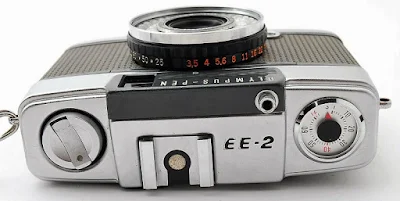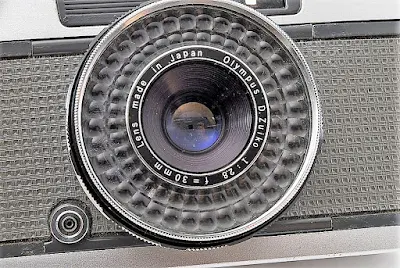The first series of Pen EE 35mm half-frame camera models (EE, EE-S, EE (EL), which were in production from 1961 to 1967, was superseded by the Pen EE-2 and Pen EES-2 in 1968. These updated models came with a hot shoe, a higher and wider film ISO speed range (ISO 25-400), a better exposure system, and hinged film backs.
While the Pen EE-2 came fitted with a fixed focus 4 elements in 3 groups D.Zuiko 28mm F3.5 lens as found on the original Pen EE, the Pen EE.S2 came with the 4 elements in 3 groups D.Zuiko 30mm F2.8 lens, similar to the ones found on the original Pen EE-S. With its wider aperture lens, the Pen EE.S2 is also fitted with a new 4-zone distance focusing system.
Production-wise, both the EE-2 and EES-2 were launched in 1968. While the Pen EE-2 stayed in production until 1977, the EES-2 ended its run in 1971. It is interesting to note that the replacement to the EE-2, the Pen EE-3, which came with a flashmatic aperture setting, was launched in 1973 and was sold alongside the former till the end of its production run.
Olympus Pen EE2
My analog Project 2011 continues in the month of June with the Olympus Pen EE2. The EE stands for "electric eye" which was an electrical exposure meter used in the Pen EE models. Lite and very compact the Olympus Pen EE2 captures half frame images on 35mm film.
Shutter speed options for both Pen EE-2 and Pen EES-2 remain at 1/40 and 1/200 second with automatic aperture opening from F3.5/F2.8 to f22 in autoexposure mode over the two shutter speeds, and 1/40 second with X-synchro flash connection in manual exposure mode.
Basic Camera Features
Though the shutter speed range of the Pen EEs may seem mundane to the casual observer, they are more than what meets the eye. The exposure range of the camera was actually regulated for maximum depth of field.
In bright ambient light, the shutter speed will be set to 1/200, and the aperture range is regulated from f/22 down to about f/8. When the light is lower than that, the camera will switch to the 1/40 second exposure, and the lens aperture will be regulated from f/11 down to its widest. Keeping the aperture from being too small is to avoid diffraction.
In a red-flag situation, i.e., when the shutter is locked due to insufficient lighting, you can still take a chance with the shot by turning off the auto-exposure mode and setting the lens to the widest aperture for flash, or by doing the exposure lock trick.
The exposure lock trick is done by first registering the exposure reading from an area that has sufficient lighting by half-pressing the shutter release, before reframing the image to the area that you want and pressing the shutter release button fully.
Just like the Pen EE, the Pen EE-2 also has a plain and simple front, with only the lens and lens mount housing, a flash sync socket on the lower left of the lens mount, and the viewfinder window located to the right of the front nameplate decal.
The lens itself is surrounded by the selenium cell screen, and at the base of the mount, the film ISO speed and aperture opening selector dial.
On the top plane, the film rewind crank is on the left, and towards the right, the hot-shoe, shutter release button, and the self-resetting film frame counter dial are on the opposite end. The shutter release button is threaded for the shutter release cable.
At the back, the viewfinder eyepiece, and the film thumbwheel crank. The film back is opened by pulling down the latch lock located at the front left bottom of the camera body.--bottom
On the bottom plate, the tripod socket, and the rewind release button recess.
The film box, with the updated easy load system first seen on the Pen EE (EL), is otherwise standard for cameras from that era.
Viewfinder Readout
The viewfinder is a simple, bright frame finder with a luminous image frame line.
When activated, the red pop-up flag for underexposure will be displayed at the bottom of the viewfinder.
Lens Equivalent
The 28mm F3.5 lens is equivalent to a 40mm focal length on a 35mm full-frame camera.
The wider-aperture 30mm F2.8 is equivalent to a 40mm full-frame lens.
Olympus Pen EES-2
A feature of the Pen EES-2, which makes it rather unique and outstanding, is the introduction of a new 4-zone focus system with the zone distance setting located on the barrel of the lens housing mount.
Compared to the very discrete and hard-to-remember 3-zone focus of the Pen EE-S, the 4-zone focus system of the EES-2, with its selection dial located just aft of the film ISO speed selector ring, is functional and the better of the two.
The design, with the same styling and auto-exposure mechanism, albeit with a full-frame lens, was also used on the Olympus Trip 35, whose production run began in 1967.
This, of course, brings to mind the difference between the 30mm F2.8 lens of the EES-2 and the 40mm F2.8 of the Trip 35, and the similarity, with both having a 40mm focal length lens or equivalent, of their performances, if any.
Using The Camera
With its increased and enlarged film ISO speed capability, with the maximum ISO speed now set at ISO 400, a hot-shoe, and a hinged film back, which brings the camera in line with the rest of the industry, the Pen EE-2 is definitely a better choice over the original Pen EE.
For current analog camera enthusiasts, furthering the option to the Pen EE-3, with its flashmatic guide for use with GN14 flash units, may not be an option at all. The simple reason is that a flash unit is seldom a necessity, and it will only add a hardly used additional load to the camera bag.
The Pen EES-2, on the other hand, is definitely on a cloud of its own. There was never a Pen EES-3. The model was an iteration of its own within the Pen EE series. Having the same functional and mechanical usability and a lens with the focal length equivalent of the iconic Olympus Trip 35 does make it a worthwhile option, a standout on its own.
























No comments:
Post a Comment